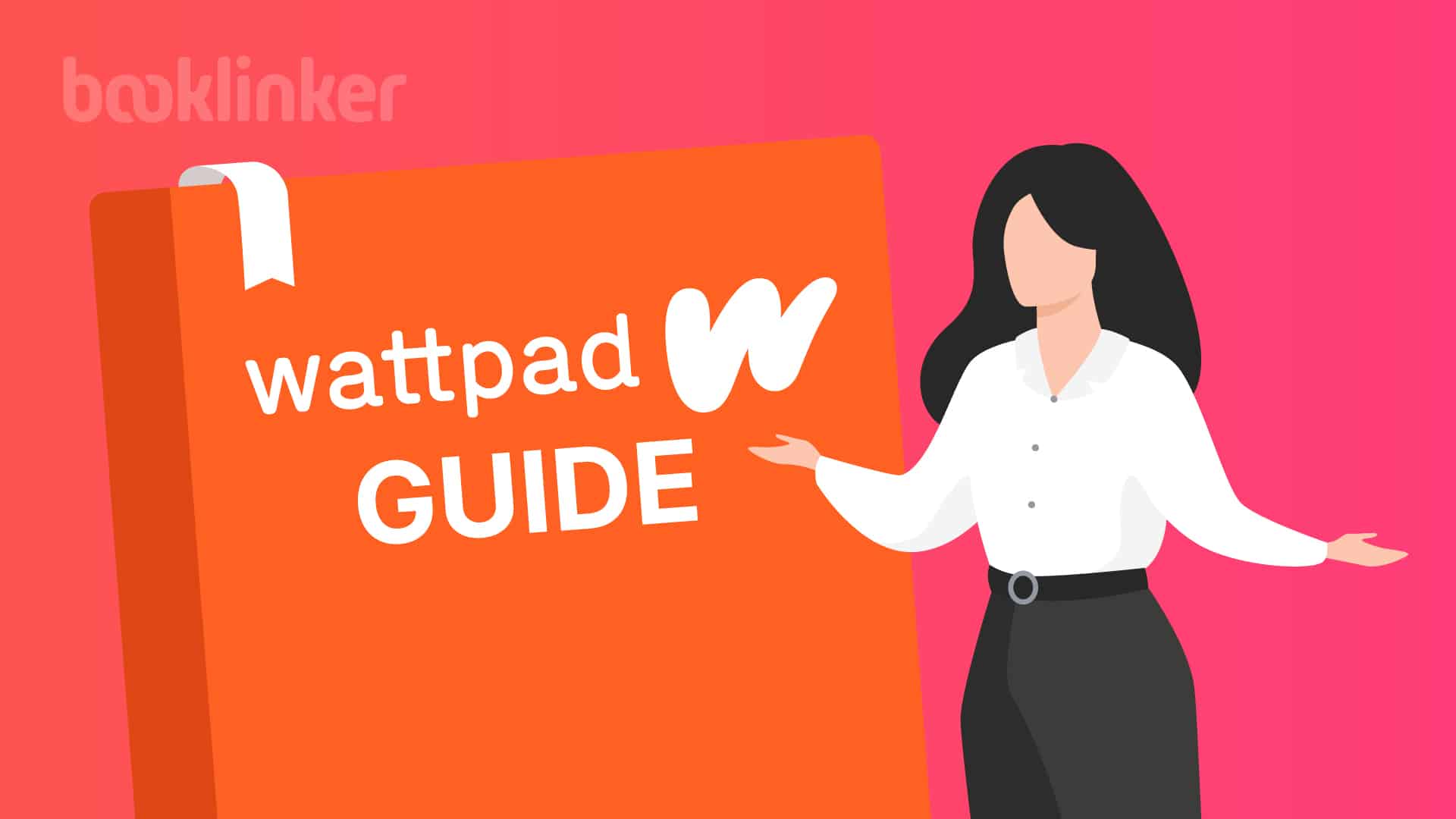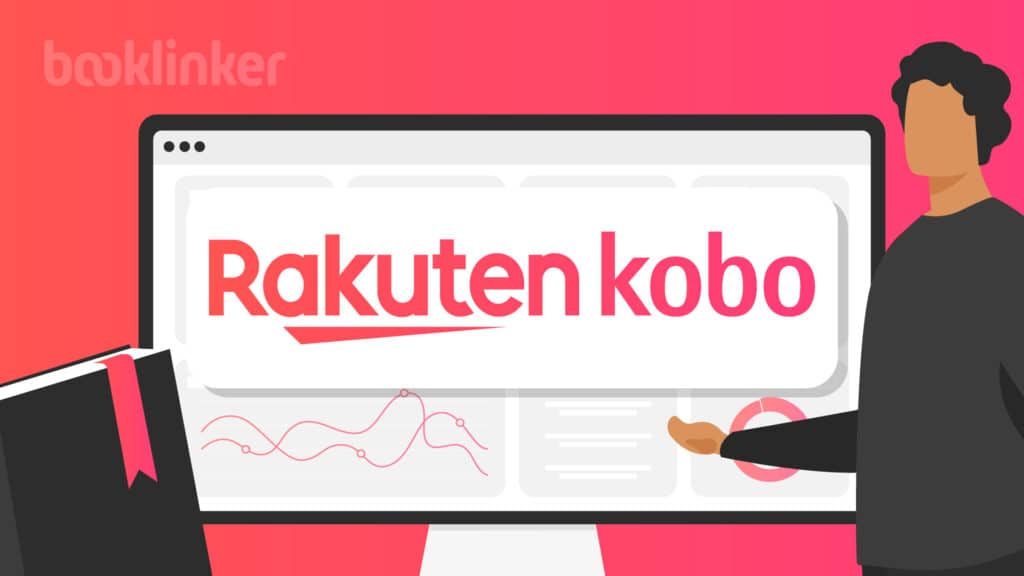
While Amazon is the largest player in the publishing world, there are many other digital publishing platforms on which, authors should consider selling their books.
Kobo is a Canadian company that offers ebooks, audiobooks, plus a range of ebook readers and it is one of Amazon’s largest competitors.
To help authors discover if publishing on Kobo is right for them, the Booklinker team spoke to Sally Jenkins, a hybrid author who started self-publishing in 2013 and signed her first traditional publishing contract in 2022.
Sally released her first self-published book on Amazon in 2013, and two years later in 2015, discovered how easy it was to publish on Kobo. In 2020, after a chat with, Tara Cremin, then Kobo’s Author Experience Senior manager, Sally published Kobo Writing Life Publishing for Absolute Beginners.
In this article, Sally shares everything that she has learned about Kobo and discusses why she decided to spend so much time and effort on the platform.
1. Global Audience
The first benefit of publishing on Kobo is greater access to a global audience. Kobo claims to have over 12 million readers in over 190 countries, which is more than Apple.
They’re particularly popular in Canada, Australia, and the Netherlands. My books have sold in over 20 different countries such as South Africa, Slovakia, and Laos.
By publishing on Kobo authors reach customers outside of the Amazon ‘bubble’. I’ve had several readers tell me that they don’t (or prefer not to) shop on Amazon so it’s great to be able to offer them a digital alternative.
2. Overdrive and Kobo Plus
Kobo offers its authors access to Overdrive and Kobo Plus.Overdrive is a separate entity to Kobo. It hosts a large catalogue of digital books which libraries can buy and add to their own digital catalogues to be lent out to readers.
This means that Kobo authors who opt into Overdrive make their ebooks available to libraries worldwide. Kobo authors set a separate Overdrive price when opting into the service and it is recommended that this is set higher than the ebook’s usual price in order to reflect that a library book will be read many times.
A secondary advantage to Overdrive is that a reader who has enjoyed a book after borrowing it from their library’s digital catalogue may then seek out and buy further books by the same author.
(Tip: UK writers can register for PLR (Public Lending Remuneration) which generates a small payment each time their e-book is borrowed from a UK library)
Kobo Plus is similar to Amazon’s Kindle Unlimited and lets readers pay a monthly subscription in order to read books “for free.” Authors can choose to opt their books into this program, and gain access to Kobo’s power readers – who get through a lot of books! And Kobo does not impose any exclusivity rules on books opted into Kobo Plus.
3. Competitive Royalties
Kobo’s royalties are competitive, if not better than Amazon’s. Kobo offers a 70% royalty on books priced at £1.99/$2.99 or more (this is roughly in line with Amazon for many countries) Below this price, royalties are 45% (compared to 35% for Amazon).
Kobo also pays a 50% royalty on library sales via the Overdrive program (see above). Royalties for books enrolled in the subscription scheme, Kobo Plus, are paid at 60% but depend on the amount of time readers spend reading each book (not pages as read, as in the Kindle model). This is calculated as 60% of ((Monthly Revenue/Minutes Read) x Number of Minutes Read of Your Book), where Monthly Revenue is Kobo’s total monthly revenue from the Kobo Plus and Minutes Read is the total time spent reading all books within Kobo Plus.
4. No Exclusivity
An important benefit for authors publishing on Kobo is that the platform doesn’t ask for any exclusivity.
Amazon’s KDP Select offer creates one of the toughest decisions for authors to make. In exchange for entry into Kindle Unlimited, authors gain higher international royalties and promotion days at the cost of having to limit themselves to publishing on Amazon. However, even though Kobo has a similar service, Kobo Plus, authors who opt into it are still allowed to list their books on other platforms.
5. Access to Kobo Promotions
Once your book is available for sale in the Kobo Store, you can put it forward for one of the many promotions that Kobo regularly runs. Promotions give higher visibility to the selected books through inclusion in e-newsletter mailings and/or prominent positioning on the Kobo website.
Click on the ‘Promotions’ tab on your KWL dashboard to see currently available promotions.
Typical promotions may include:
• Inclusion on the Kobo ‘Free Page’ for a particular genre. This is a useful way of pushing the first book in a series for free in order to hook the reader to buy later books in the series. There is usually a small fee for this type of promotion and it won’t generate immediate royalties. Think of it as a building block for the future.
• Daily Deal Homepage Placement. The Daily Deal features prominently on the Kobo homepage in specified countries and may also feature in e-mails and banners on site. To be eligible, the book’s price must be discounted and there is also a fee to pay.
• Sales linked to holidays and special days, such as Mother’s Day, Christmas etc. The terms of these promotions vary. They may offer readers discounted books or multi-buy offers. The ‘fee’ is generally a ‘no risk’ reduction in royalty rate.
• Box Set sales. These generally require books to be discounted.
Kobo promotions are manually curated i.e., not every book put forward for a promotion is accepted. Read the terms of the promotion carefully to be clear about what type of book is eligible and what is required regarding price and discounts.
During my time on Kobo I have been accepted for 66% of the promotions I’ve applied for.
Tip: Better to publish directly with Kobo rather than go through one of the digital distributors because the opportunity to take part in promotions is only available to authors publishing directly (and you get to keep all the royalties!)
Kobo Writing Life Dashboard
The KWL Dashboard is a ‘one-stop shop’ for authors. It gives access to the e-book and audiobook uploading process and to any changes that need to be made post-publication. It also allows authors to access their sales figures and the all-important promotions tab.
Kobo is in the process of introducing a new dashboard but the following screenshots give some idea of what to expect from the dashboard.
An example of setting up the ebook description information:
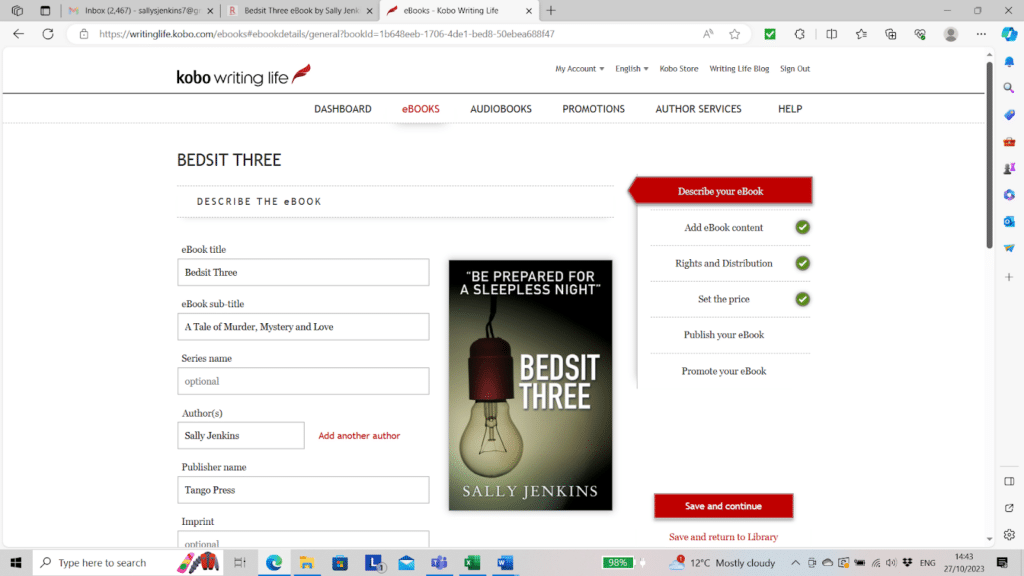
An example of the Promotions tab (highlighted in red) and the Promotions page:
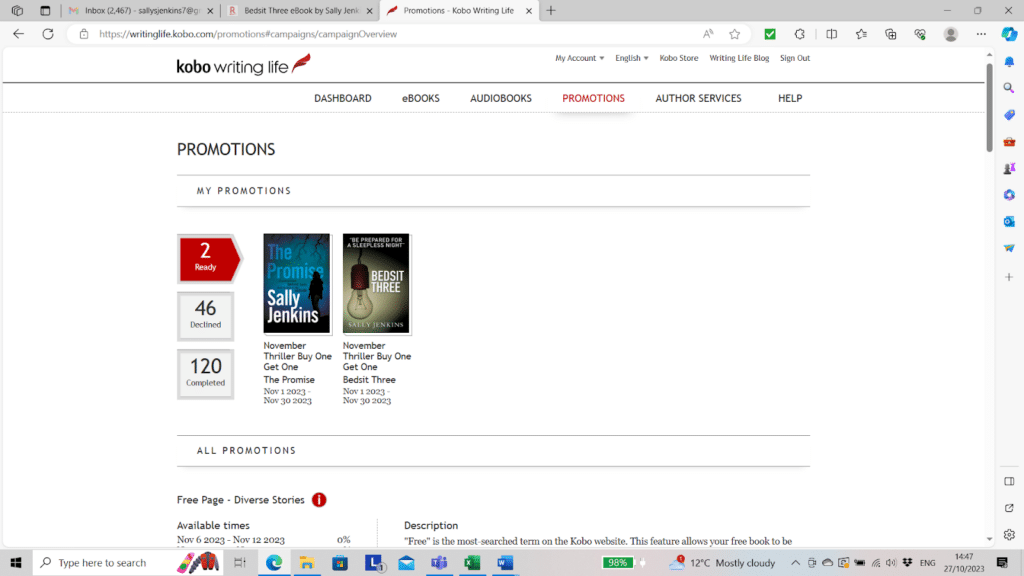
An example Sales Trend Graph:
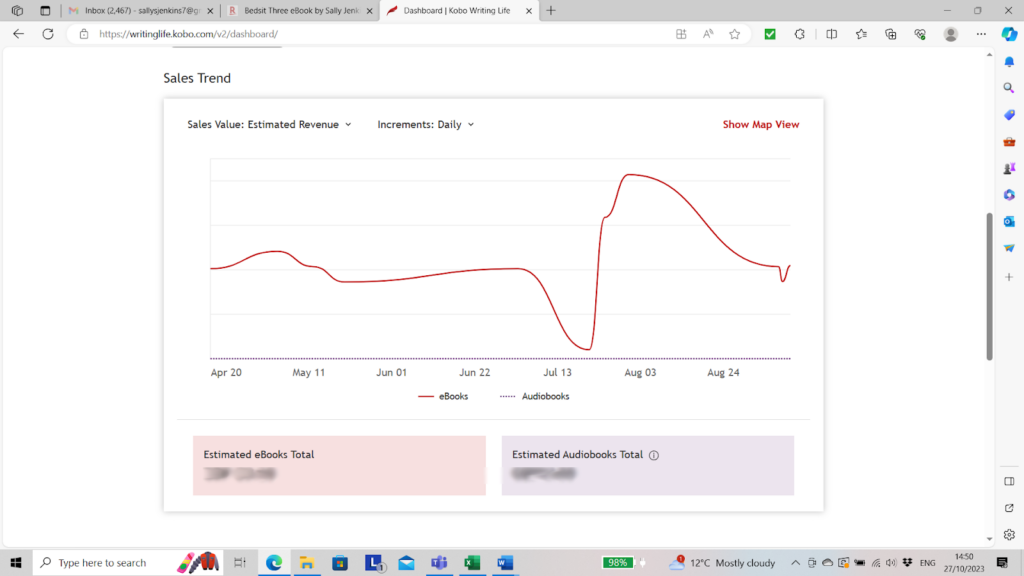
Uploading Your Book on Kobo
Manuscripts can be uploaded to Kobo in either epub or .doc format. If an author uploads their book in .doc format, Kobo will automatically convert the file into epub format. Kobo provides guidelines on how to ensure that your Word document will convert correctly: https://kobowritinglife.zendesk.com/hc/en-us/articles/360058975512
Tip: The main thing to remember is, like Kindle books, Kobo page sizes depend on the device a reader is using and the font size they have chosen. Therefore, remove all page numbers from your manuscript. Also, Headers and Footers are not supported.
Kobo recommends that you use one of the following fonts:
- Times New Roman
- Arial
- Courier New
Lastly, the cover design must be professional-looking, especially if you want to take advantage of Kobo promotions. Kobo’s tips are here.
Uploading Your Book and Setting a Price
After uploading your book to Kobo, ALWAYS download the epub file to make sure that everything is converted as you expect! You can preview the file on a Kobo e-reader, in the Kobo app, or via one of the many free ePub viewers available online, for example, Adobe Editions and Calibre.
(Tip: I use the free Calibre). Details: https://kobowritinglife.zendesk.com/hc/en-us/articles/360059386391-Previewing-Your-Book
Once the default price has been set (according to whether you want 70% or 45% royalties), Kobo will calculate the equivalent price in the currency of all its regions.
Tip: Edit these calculated prices to end in .99 or .49 to make them more attractive to buyers.
After a book has been published, it’s possible to schedule a price change or a limited-time sale price via the pricing page.
Opting Into Kobo Promotions and Marketing Opportunities
When logged into your Kobo Writing Life account, there will be a ‘Promotions’ tab on the Kobo dashboard which lists the promotions currently available. See above for an example of the Promotions page.
Tip: Check this tab regularly to make sure you don’t miss anything.
Some promotions require the price of a book to be discounted – this means that the author will also have to discount on Amazon Kindle too, because of the KDP pricing rules. Other promotions are the ‘Buy 2 Get 1 Free’ type and therefore there is no need to price match on Amazon too – I prefer these.
It’s also possible to sign up for a Kobo mailing list and hear about upcoming promotions. There are also occasional promotions in conjunction with Overdrive.
Tip: To stand the best chance of being accepted into a promotion, your book must have a good, professional-looking cover (when I queried why one of my books was continually turned down for promotions but another was almost always accepted, I was told it was because the cover of the first book was not professional enough).
Tip: Email support@kobowritinglife.zendesk.com and ask to be added to emails giving news about forthcoming promotions (Kobo & Overdrive) plus any that are specific to your genre (I receive email about crime & thriller promotions)
Conclusion
For the authors that decide to publish their books wide, Kobo makes a great choice due to its large international presence, growing market share, competitive (if not higher) royalty rates, and powerful programs such as Overdrive, Kobo Plus, and more.
If your books are doing particularly well in Amazon KDP Select you may not want to risk pulling out of that exclusivity.
But for authors that are not exclusive, publishing on Kobo makes a lot of sense.
Author
-
Sally Jenkins lives in the West Midlands of England with her husband. When not writing and not working in IT, she feeds her addiction to words by working part-time in her local library, running two reading groups and giving talks about her writing. Sally can also be found walking, church bell ringing and enjoying shavasana in her yoga class.
https://sally-jenkins.com/



